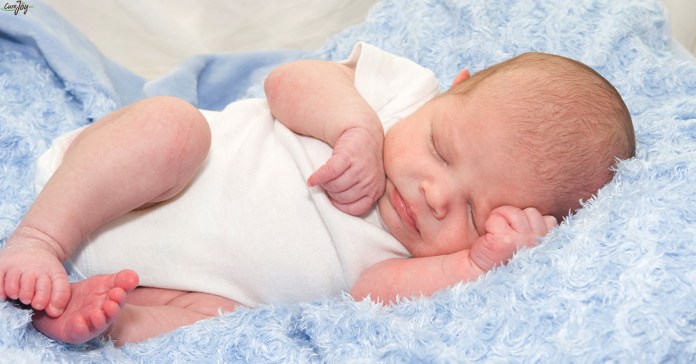Sleeping positions of a baby are very important and can cause Sudden Infant Death Syndrome (SIDS). It is known about 2,500 babies die every year in the U.S. due to SIDS. The most effective and best way to avoid the risk of SIDS is to put your healthy baby to sleep on his back or in the supine position.
Here are a few tips you could practice to avoid SIDS in your newborn.
Causes Of Sudden Unexpected Death In Infancy (SUDI)
SUDI combines both SIDS and fatal sleeping accidents. Common practices that could to SUDI:
- Putting your baby to sleep on his stomach or side.
- Letting your baby sleep on soft surfaces like mattress, sofa, waterbed, pillow or the likes.
- Covering his head with bedding.
- If you smoke during pregnancy or after childbirth.
The Best And Worst Sleeping Positions For Your Baby
1. Sleeping On Back
Babies should be put to sleep on their backs be it for short naps or for a long duration of sleep in the night. Babies who slept on their back were found to be less prone to SIDS as sleeping on the back keeps the airways open. The US National Institute Of Child Health and Human Development (NICHD) claimed this position to be the best for babies.
Risks Involved In This Position
All things have risks and cons. It is said if you let your baby sleep in the same position for a very long time, it could lead to positional plagiocephaly or brachycephaly. Positional plagiocephaly is a flattened or a misshapen head and brachycephaly is the flattening of the back of your baby’s skull.
Tips to avoid such condition are:
- Increasing your baby’s ‘tummy time’ when awake.
- Resting baby on the other side of his head rather than on the flattened side.
- Cutting down your baby’s time in carriers or car-seaters.
- Changing your baby’s direction in the crib so that he does not tend to view same things in one direction always.
2. Sleeping On Stomach
There are many theories that bring out the risks of putting your baby to sleep on his stomach.
- It could put pressure on your baby’s jaw and thus reduce the airway and restrict breath.
- When your baby sleeps on his stomach, his face may be very close to the sheets causing him to breathe the same air.
- Your baby may suffocate if he sleeps on his stomach on a soft mattress.
- Your baby may breathe microbes present in the mattress.
Can Babies Sleep On Their Stomach?
- Doctors say sleeping on the stomach is sometimes good for babies with gastroesophageal reflux or babies with the Pierre Robin Syndrome. These can obstruct your airways and may lead to episodes.
- The prime worry was if babies vomit while sleeping on their backs, they may choke on their own vomit. So some doctors say putting your baby to sleep on his stomach sometimes could eliminate this danger.
3. Sleeping On The Side
It is unsafe for babies to sleep on the side because they may end up sleeping on their tummy, increasing the risk of SIDS.
10 Tips On Your Baby’s Sleep:
- Avoid loose bedding. Don’t use waterbeds, soft mattress or cushions for your baby. Experts advise using bumper pads, pillows and stuffed animals around the baby in the crib are fine. It is best to use a firm mattress for your baby.
- Keep your baby’s crib simple. Refrain from using wedges, quilts or comforters under your baby in the crib. Make sure your baby’s feet touch the bottom of the crib and use a firm mattress that fits well and tucks in the bedclothes properly.
- Don’t cover your baby’s head. Blankets should cover only your baby’s chest and should expose your baby’s arms and head. Sleeping bags with a fitted neck and armholes, without a hood, are considered the best and safest for your baby.
- Dress your baby light and loose for the night. Don’t over-bundle your baby and check if he is hot to touch.
- Maintain a good sleep environment for your newborn.
- Get your baby’s vaccines on time. A recent study shows that increases DTP immunization coverage is associated with decreased SIDS mortality.
- Use a pacifier. The American Academy of Pediatrics claims using pacifiers can prevent SIDS at times.
- Make use of technology to have a peaceful and sound sleep while you can still monitor your baby through apps and other small devices.
- Share your room with your baby. This will be convenient in the initial stages when you have to breastfeed your baby.
- While it is good to share your room, do not share your bed with your newborn. Newborns should not share a bed with their parents, siblings or even twins. If your partner or you smoke, drink or take drugs which induce sleep, don’t share your bed with your baby. Smoking and the use of a substance like drugs or alcohol significantly increase the risk of SIDS and suffocation in babies, if the bed is shared.





